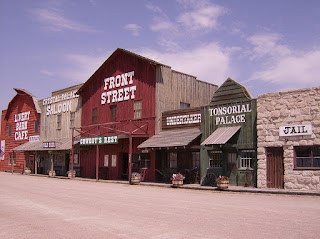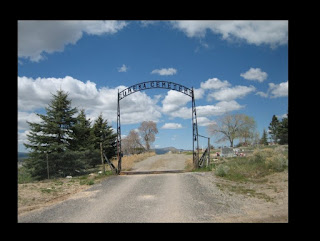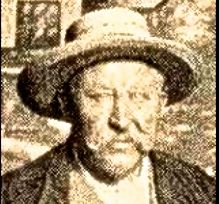William "Billy" Wood, Eureka, Utah
Billy Wood and Death by Fly Paper
Foreword: Given the easy access to strong drink, I find it somewhat surprising that of the some 680 whiskey men I have profiled, only two definitely have been identified as becoming alcoholics.The saloonkeeper whose short biography appears below is one of them. In his case, the outcome was tragic in the extreme.
William H. “Billy” Wood was well-known and for a time well-respected in Eureka, Utah, a pioneer settlement that grew from a mining camp to become the largest city and the center of commerce for an entire region. Billy Wood contributed to that development as well being a popular saloonkeeper whose Oxford Resort, according to press reports: “…Had the best business in town.”
 Billy was born about 1866 in Pleton, Ontario, Canada, the son of David and Deberiah (Welbank) Wood. His early life, education and immigration into the United States have gone unrecorded. By his early twenties he was working in the general merchandise and hotel business in Ogalalla, Nebraska. Located in western part of the state, Ogalalla had been a stop on the Pony Express and later famous as a terminus for cattle drives from Texas to the Union Pacific railhead located there. Ogalalla’s main street, shown here, has been reconstructed to reflect its early history.
Billy was born about 1866 in Pleton, Ontario, Canada, the son of David and Deberiah (Welbank) Wood. His early life, education and immigration into the United States have gone unrecorded. By his early twenties he was working in the general merchandise and hotel business in Ogalalla, Nebraska. Located in western part of the state, Ogalalla had been a stop on the Pony Express and later famous as a terminus for cattle drives from Texas to the Union Pacific railhead located there. Ogalalla’s main street, shown here, has been reconstructed to reflect its early history.
In 1892 Wood pulled up stakes in Nebraska and likely boarding a Union Pacific train traveled west to Ogden, Utah, then trekked the 100 miles south to Eureka. He arrived the year the city incorporated. Why he chose Eureka is unclear. As it is shown above in a colorized photo from its early days, the town was just one street of ramshackle buildings. As mining production increased, however, Eureka’s population grew, triggering a commercial and residential building boom. Wood’s early days in Eureka go unrecorded but the assumption is that he was running a saloon.
 Disaster hit the town in 1893 in the shape of a fire that burned out most of Main Street. Fearing a repeat, elected officials decreed that any new buildings had to be constructed of brick or cement block. Wood-framed structures were to be covered with iron-clad sheeting. Townsfolk quickly began to rebuild. Among those leaping into action was Billy Wood. By this time the Canadian immigrant had achieved some wealth. He pitched in by spending $25,000 (equivalent to $550,000 today) to construct a block of storefronts. They can be seen in this 1890s photo of Eureka’s Main Street, identified by the awning at right.
Disaster hit the town in 1893 in the shape of a fire that burned out most of Main Street. Fearing a repeat, elected officials decreed that any new buildings had to be constructed of brick or cement block. Wood-framed structures were to be covered with iron-clad sheeting. Townsfolk quickly began to rebuild. Among those leaping into action was Billy Wood. By this time the Canadian immigrant had achieved some wealth. He pitched in by spending $25,000 (equivalent to $550,000 today) to construct a block of storefronts. They can be seen in this 1890s photo of Eureka’s Main Street, identified by the awning at right.
As part of his complex Wood opened an establishment of 4,000 square feet he called “The Oxford Resort.” The letterhead shown here provides clues to his operation. Billy was running a saloon and cafe as well as selling liquor and cigars at retail. The reference to private club rooms suggests on-premises gambling and possibly sexual activity.
 The emphasis on A.B.C. beer indicates his was a “tied establishment,” reaping extra profits by featuring only the advertised brew from St. Louis. Wood’s place became the most popular drinking establishment in Eureka. A genial personality was a prerequisite for a successful publican. Billy had that “in spades” as well as a reputation as a “sporting man,” willing to bet on almost anything.
The emphasis on A.B.C. beer indicates his was a “tied establishment,” reaping extra profits by featuring only the advertised brew from St. Louis. Wood’s place became the most popular drinking establishment in Eureka. A genial personality was a prerequisite for a successful publican. Billy had that “in spades” as well as a reputation as a “sporting man,” willing to bet on almost anything.
By this time Billy had married, fathered two daughters, and gradually, as his obituary put it, developed “an uncontrollable appetite for alcohol.” Recognizing the strains his drinking was putting on his marriage and business, Woods twice put himself into the hands of the Keeley Institute, a nationwide chain of 200 clinics that claimed to offer a “scientific” cure for alcoholism. Despite glowing testimonials from former patients, the medical profession was skeptical. Keeley treatments clearly did Billy little good. In the Fall of 1899, returning from a “Keeley Cure” on the West Coast, he resumed his drinking almost immediately and his wife made good on her promise to leave him unless he reformed.
 Plunged into despair, Wood decided on a desperate way out. According to his obituary in the Salt Lake Tribune of September 22, 1899, he soaked strips of flypaper in water, knowing that they contained arsenic. Then he drank the water. Death by arsenic poisoning is not an easy way to commit suicide. Symptoms begin with headaches, severe diarrhea, and drowsiness. When the poisoning becomes acute, symptoms include diarrhea, vomiting blood, muscle cramps, stomach pain and convulsions. The final result of arsenic poisoning is coma and death. Wood’s suicide occurred when he was only 33 years old.
Plunged into despair, Wood decided on a desperate way out. According to his obituary in the Salt Lake Tribune of September 22, 1899, he soaked strips of flypaper in water, knowing that they contained arsenic. Then he drank the water. Death by arsenic poisoning is not an easy way to commit suicide. Symptoms begin with headaches, severe diarrhea, and drowsiness. When the poisoning becomes acute, symptoms include diarrhea, vomiting blood, muscle cramps, stomach pain and convulsions. The final result of arsenic poisoning is coma and death. Wood’s suicide occurred when he was only 33 years old.
With his funeral arrangements and cortege organized by his fraternal brothers in the AOUW, Wood’s body was carried to the Eureka Cemetery and interred there. Among the mourners were his widow, identified as proprietress of the Oxford rooming-house, and his daughters. Billy’s saloon then fell into other hands, operating until the onset of Utah’s statewide prohibition in 1917. Subsequently the building, as shown below, was allowed to fall into disuse.
 Restored to some extent in recent years the building now bears a plaque that was paid for and placed there in 1999 by Eureka residents. Shown here, It reads: “OXFORD RESORT — Built in 1893 as a saloon. In the 20th Century much fun was had in this building.” In the light of the tragic history of the man who created the Oxford Resort, that last sentence seems highly ironic.
Restored to some extent in recent years the building now bears a plaque that was paid for and placed there in 1999 by Eureka residents. Shown here, It reads: “OXFORD RESORT — Built in 1893 as a saloon. In the 20th Century much fun was had in this building.” In the light of the tragic history of the man who created the Oxford Resort, that last sentence seems highly ironic.
Notes: Although the information for this post was drawn from a number of documents, the principal source was the obituary of Wood that appeared in the September 22 issue of the Salt Lake Tribune, published the day after the saloonkeeper’s death.







Comments
Post a Comment